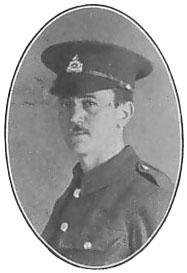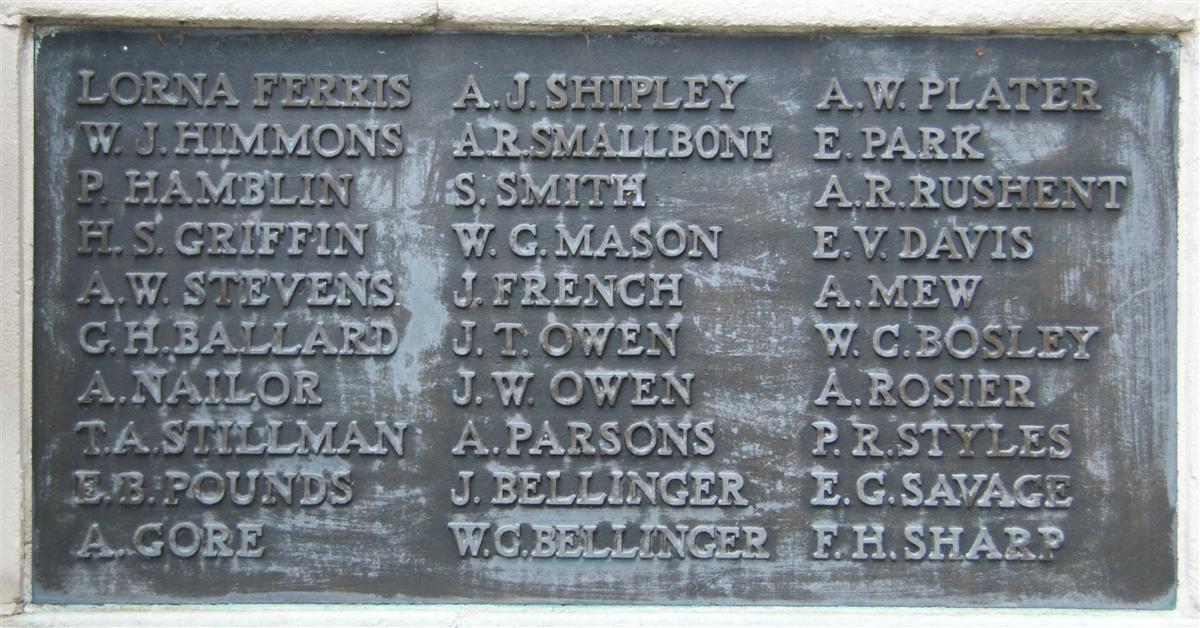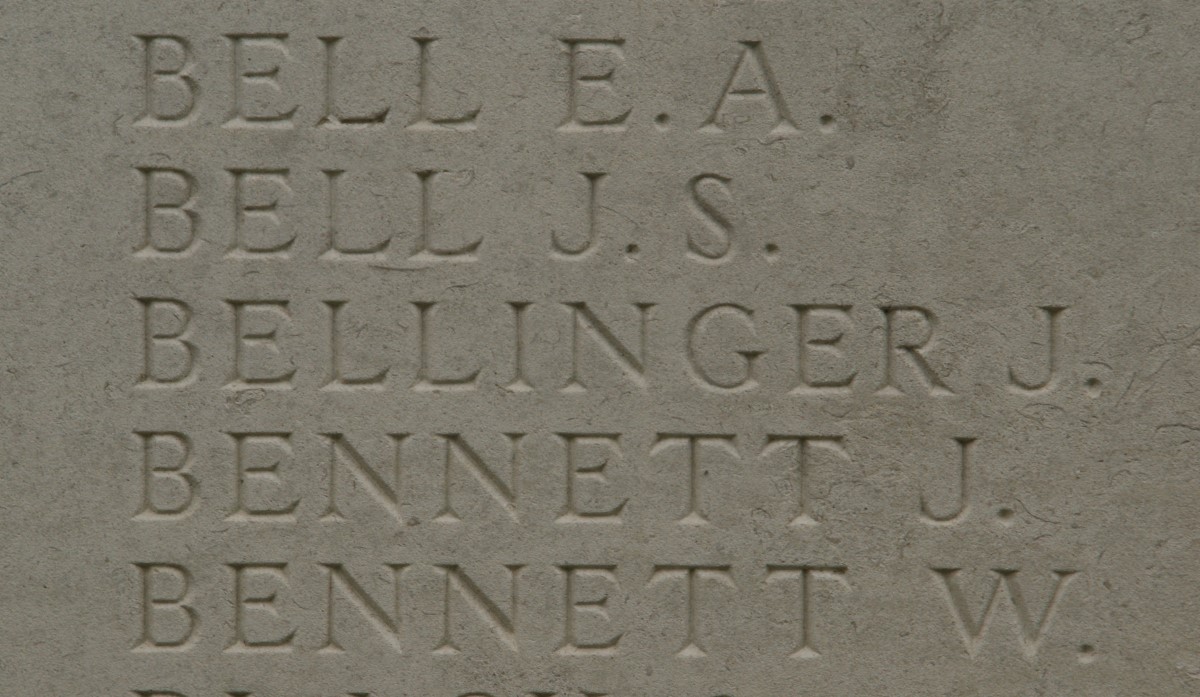John Bellinger
Private 181215, John Bellinger, 1st Battalion, Royal Berkshire Regiment
 John Bellinger. |
John was born on 6 February 1884, the son of George Bellinger and his wife Elizabeth née Wright. His father was a bricklayer. By the time of the 1901 census his eldest sibling, Alice, had already married and left home; presumably to escape the cramped conditions in the family home in Adey's Buildings. John was staying with Alice and her husband. Even with these two missing there were eleven of the family in their small terraced house. Elizabeth died in 1909, further complicating the care for the children.
John married Phoebe Lovelock on 21 September 1907 and their first, and only child, Evelyn Maud, was born on 11 March 1909. They lived in Ashton Court in Newbury. Ashton Court was one of the many courts and yards leading off Newbury's main streets, filled with small cottages where most working class Newburians lived, many of them little more than slums. Ashton Court was behind the Falkland Arms on the east side of Bartholomew Street. The whole area was flattened in the 1970s and is now covered by the Kennet Centre shopping complex.
When war broke out in 1914 it did not take John long to decide to 'do his bit'; he enlisted in December 1914 joining the Royal Berkshire Regiment. Initially he would have been assigned to the 3rd Battalion, a training unit that supplied men to the combat battalions (at this time the 1st and 2nd Battalions). In May 1915 he was one of many sent to France to join the 1st Battalion as a replacement.
The British were planning an attack on the German lines near the coal mining town of Loos-en-Gohelle in northern France, part of a major Anglo-French offensive known as the Battle of Artois. This element of the larger offensive was to earn its own name as the Battle of Loos. It was the first time the British used poison gas (chlorine).
The 1st Battalion were in reserve on the day of the opening advance (25 September 1915) but were called into action on 28 September. They were attached to the 7th Division which was tasked with the capture of a section of the German lines in an area known as The Quarries between Hulloch and a mine called Fosse 8. The 1st Battalion's specific rôle being to attack a strongpoint known as the La Bassée Railway Triangle Redoubt (passing through the lines captured by the first wave of the attack). Things went awry from the start and the Battalion's objective was changed to Fosse 8 itself (if everything had gone to plan this would have been catured by the first wave, before the 1st Battalion moved forward). Attacking in bright moonlight at 2.30 am, passing through trenches captured by the first wave, they moved forward, until they were spotted 400 yards short of the German positions.
The entry in the Battalion's war diary tells the story:
12.30 am. Battalion collected from fatigues and working parties in order to attack FOSSE No 8 at 2.30am. Capt Radford DSO went to the Brigade HQ at the VII Divisional Dugouts to explain that the battalion were scattered on fatigues and that the position to be attacked and the approaches were strange to the officers.
Personal message from General Gough (1st Corps) explained that owing to the situation the attack was imperative.Coys moved in file to the rendezvous A. B. C. D. HQ & MGs. Here the battalion formed up in Company Column and advanced towards the objective 800 yards away. During the advance two lines of captured German trenches and two lines of barbed wire had to be crossed - these were manned by British troops.
Owing to the bright moonlight the enemy saw us advancing when we were 400 yards from our objective (FOSSE 8): they put up "very" lights and kept up a continuous rifle fire on us from our right front - this grew heavier as we got nearer.
The battalion advanced steadily A, B and part of C Coy going straight for the FOSSE. They were unable owing to the heavy fire from the enemy who by this time were manning the top of the FOSSE to gain the slag heap, being checked about 70 yards from it. D and part of C Coy meanwhile advanced and manned the front British trench.
During this time 2nd Lieut A B Turner single handed bombed down a German communication trench driving the enemy before him a distance of over 150 yards. During the whole of this period the Germans were throwing bombs at 2/Lt Turner. While performing this very gallant act he was mortally wounded. By this time it was known that the CO Major Bird was wounded and Capt Radford DSO 2nd in command was killed. In consequence the command devolved on Capt C W Frizzell who was in command of the rear company D: also by this time Colonel Carter the Brigadier was up in the first trench.
Seeing that the first two companies were checked Colonel Carter gave Captain Frizzell the order to charge with the remaining men available, this order was carried out - the leading men with Capt Frizzell in front got half way up the slag heap when the Germans from the top threw bombs on our heads. This checked our further advance and the men retired to the front British trench a distance of 150 yards.
As it was now getting daylight and the men were all rather exhausted Colonel Carter decided not to attack again. He ordered Capt Frizzell to re-organise in our old trenches.
Casualties. Killed. Capt M C Radford DSO. Died of wounds 2Lt A B Turner.
Missing. Capt E N Getting, 2Lt P C Rawson 2Lt R A Summers, 2Lt J W B Blazey. Wounded and missing. Lieut G F M Hall.
Wounded. Major L W Bird, Lt E F Eager, Lt D E Ward, 2Lt Haigh, 2Lt W S Mackey and Capt Adj C St Q Fullbrook Leggatt DSO.
Other ranks. Killed 17 missing 143 wounded 115. Total 288
The death of Captain Radford cannot be too much deplored. He was a very gallant officer and his loss is very keenly felt by everyone in the regiment and brigade. He was buried at Vermelles.
Search parties under Captain Large were untiring in the devoted manner they searched for the wounded.
The 1/2 Battn 1st KRR were not able to reach the rendezvous and attack with us. Also the bombing parties from the regiments on our flanks were not there.
2nd Lieut A B (Alexander Buller) Turner was from Thatcham, his actions that night won the regiment's first VC of the war.
John was among the missing; his wife was notified in November:

John Bellinger's name on Newbury War Memorial (lower middle) |
Newbury Weekly News, 18 Nov 1915 p8 – Local War Notes
Official news has been received by Mrs Bellinger, of 5, Ashton-court, Bartholomew-street, Newbury, that her husband, Pte J Bellinger, of the 1st Royal Berks, has been missing since September 28th. He enlisted on December 29th, went through his training at Portsmouth, and left for France in the 4th of May. His wife and friends would be glad to receive any information regarding him.
His family were left wondering if he might have survived, but, as the days and weeks passed with no news of him being a prisoner of war their hopes must have faded. Almost a year after the attack John's wife received official notification that he was being assumed dead.
Newbury Weekly News, 21 Sep 1916 p8 – Local War Notes
Notification has been received by Mrs Bellinger, of 5, Ashton Court, Bartholomew-street, Newbury, with a letter of sympathy from the King and Queen, of the death of her husband, Pte J Bellinger, 18215, of the Royal Berks, who has been missing since September 28th, 1915. Deceased, who was formerly employed by Messrs Plenty and Son, King’s-road, Newbury, joined the service in December, 1914, and left for France on May 4th, 1915. Another brother, Acting Leading-Stoker W Bellinger, was lost May 31st on HMS Queen Mary, in the Jutland Battle.
 John Bellinger's name on the Loos Memorial. |
After the war a number of memorials were erected near the battlefields to commemorate the names of those men whose bodies were never found or identified. John Bellinger's name is recorded on Panel 93 of the Loos Memorial at the Dud Corner Cemetery just outside the town.
Locally John is remembered on Panel 1 of Newbury's Town War Memorial, on a memorial board and a roll of honour in St Nicolas' Church, Newbury, and on the impressive memorial in the United Reform Church, Newbury.
As mentioned in the newspaper item above, his younger brother William was lost at the battle of Jutland, his story can he found - here.
He also had a cousin, John Preston, who died serving with the Royal Berkshire Regiment. His relationship with Preston was complicated when his father married Preston's mother in 1912 (their mother's were sisters Elizabeth and Ann Wright). Following this marriage Preston was both cousin and step-brother.
For a detailed account of the 1st Battalion's part in the Battle of Loos - click

Find a memorial :
| Died this day: | |
| 14 January 1946 | |
| Henry Charles Waite | |
| Upper Basildon |

Like this site? Show your appreciation through a donation to a great charity.